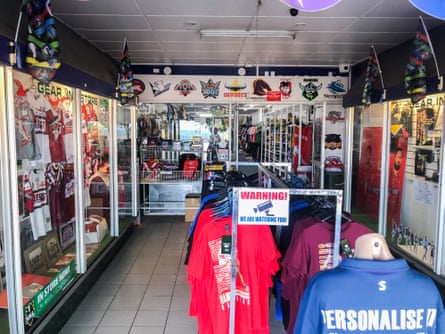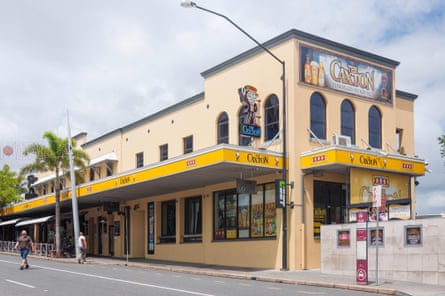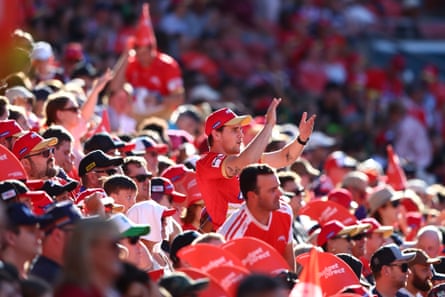Across all its major sporting codes, Brisbane is a one-team town.
Melbourne has its ancient Aussie rules enmities, Sydney its suburban rugby league tribes – not to mention rival teams in the round-ball game and T20 cricket. In Adelaide and Perth, clashes between crosstown AFL teams are the hottest tickets in town.
Brisbane, though, until now, has possessed nothing comparable.
So the novelty of Friday’s inaugural meeting between the Brisbane Broncos – the football club which defines the river city more than any other – and the Dolphins – the NRL’s new kids on the block – goes a long way to explaining the hype behind a derby being dubbed ‘the battle for Brisbane’.
There is also a dash of fairytale in the Dolphins’ unexpected run of wins and the Broncos’ return to imposing form after years of floundering. Then enter Wayne Bennett – founding father of the Broncos and now the Dolphins – and you have a story the league’s boardroom administrators could hardly have dared script.
The city’s cathedral of rugby league, the 52,500 capacity Lang Park, sold out days in advance. Friends are ending conversations with the ‘phins up’ catchcry as a parting salutation and patrons enter pubs with their palms pressed together, prayer-like and raised to their foreheads as if finned.
In a rabbit warren of arcade stores – op shops, two dollar stores, sellers of records and nick nacks – beside the Redcliffe jetty in Dolphins heartland, Louis Murray sells rugby league merchandise from a hole in the wall he’s run for almost 20 years.
“I’ve never seen nothin’ like it,” he says. “It’s like a Myer sale whenever you open the door now.”


From the moment they were awarded the NRL’s 17th franchise 18 months ago, Murray says the Dolphins became his bestselling club. Loyal customers who had “dropped thousands on” his most popular teams – the Broncs, the Cowboys, the Eels, the Bunnies – were suddenly buying all three Dolphins jerseys. “We’ve gone from, on a Saturday, two staff to five – and that’s not enough,” he says.
When the Dolphins defied the odds and won their first top-flight game against the Roosters, his sales records were eclipsed in a matter of hours. Then it happened the next week against Canberra. Then again against Newcastle. “The hunger was there,” Murray says. “And it’s just built every week.”
But while this is the opening of a new chapter in the city’s rugby league history, for many it is something of a return to a vanished golden era.
Ash Vienna is a venue manager at the Caxton Hotel in the shadows of Lang Park. For decades, the street and the pub have been synonymous with the Broncos. The club’s legends are immortalised on its walls, and post-match revelry and scandals have played out in its beer gardens. Vienna is too young to remember it any other way.

But before the Broncos were formed and a nominally national league was born in 1988, this was the centre of a vibrant competition between suburban-based clubs: the Brisbane Rugby League. Here the Redcliffe Dolphins first cut their teeth in 1960, 13 years after the club was founded.
“We’ve all seen the videos from back in the day and, yeah, it was wild,” Vienna says of the BRL era. “It feels like that’s slowly coming back. This new rivalry is just adding to the street and the atmosphere.”
Across the street from the Caxton, the Lord Alfred hotel has dubbed itself the official Dolphins pub. Hallmark Group sales manager Luke Mellers says the 1,100-capacity venue was an “absolute sea of red” for the Dolphins’ inaugural Lang Park clash.
For this first Brisbane derby, the Alfred is throwing a car park party with live music and bars outside. “So we’ll probably stretch that 1,100 a little further,” Mellers says.
The publican reckons that, in Redcliffe, the NRL hit on a geographic goldilocks – just close enough to be considered a second Brisbane team and just far enough out to have its own distinct identity.
And he’s made another observation of his new clientele which might explain why the Dolphins instantly hit upon a vein of supporters. “Redcliffe seems to be a real family club,” he says. “It’s such a big club with so many junior teams, that’s been really represented in the crowds that have come through.”
after newsletter promotion
In a down-at-heels arcade beside Murray’s footy merchandise shop near the jetty, a visitor might just stumble upon the Redcliffe Wall of Fame. The long line of framed A4 biographies and portraits of the peninsula’s favourite sons and daughters are dominated by league legends: ‘Big Artie’ Beetson, Ian ‘Bunny’ Pearce, Dick ‘Tosser’ Turner among them. Here, too, is a pictorial history of the Dolphins, including a black and white photo of Dolphin Oval with a horse grazing on its long grass.

The whole arrangement is as far from a slick marketing campaign as one could imagine – it represents something entirely different. Unlike other expansion clubs created from scratch in what administrators might describe as “emerging markets”, the Dolphins rose from a storied club in rugby league heartland.
Which explains why Carrie Te Wani, an administrator at the Queensland University of Technology law school, and her whole family have been to every trial and season match at Dolphin Oval and Lang Park, and have become one of more than 25,000 new Dolphins members, despite previously having loyally backed other NRL clubs.
Because Te Wani’s adult son played for, and her husband coached, junior Redcliffe Dolphins teams.
“I can hear the Dolphins’ stadium from my house,” she says. “I know they represent a broader area now, but I think in the heart of hearts of Redcliffe people, they’ll always be the Redcliffe Dolphins.”

And then there’s the fact that “they’re in the community” – Te Wani sees the players around town, going about their business.
Which stands in stark contrast to Dr Julie Kelso’s experience. The Australian Catholic University sessional lecturer in philosophy of religion and feminism, biblical scholar and Brisbane Broncos tragic says she hasn’t seen one of her sporting idols out and about for years.
What she has seen, though, which struck her, were the hundreds of football fans crowding into bus stops in unfamiliar guernseys when she drove to her Taigum home down Gympie Road on the first Sunday of March.
It wasn’t an ignorance of the game by which Kelso initially failed to recognise those Dolphins’ strips on the day of their first NRL match, rather her deep connection to it.
“I’m used to the old, ‘70s ‘Bunny’ Pearce days with the red and white,” she says.
Kelso’s dad Peter played for the Northern Suburbs in the 1960s and 70s, and the “dyed-in-the-wool rugby league girl” grew up watching him on the hallowed turf of Lang Park.
So when Kelso saw those hordes of new fans, she was struck by emotion she hadn’t felt since childhood – though one she recognised from her time in Melbourne.
“That feel of the obsessiveness of fans, that’s going to bring a lot to the game in Brisbane,” she says. “I think this is the beginning of a fostering of a stronger rugby league culture and following.”

 1 year ago
114
1 year ago
114










 English (US)
English (US)